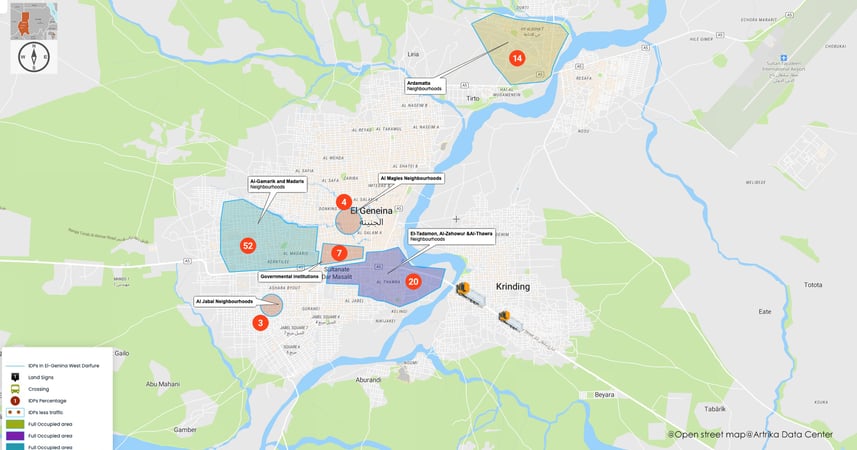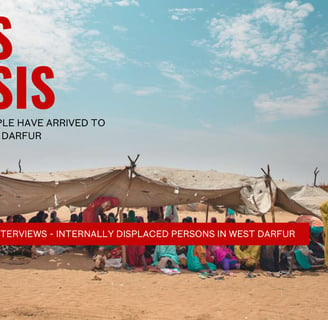

Internal Displacement in Darfur: January 2024 - April 2025
Artrika
April 2025
From January - April 2025, Artrika has documented a rise in displacement from Khartoum, El Gezira, Sennar, and North Darfur states. Sudan is the world’s worst humanitarian crisis: in the two years since conflict erupted on 15 April 2023, over 12.8 million have been internally displaced, with the majority still in the country and at risk of future violence. On the second anniversary of the conflict the country continues to be engulfed in flames, with the recent destruction of the Zamzam internally displaced persons (IDP) camp by the United Arab Emirates-backed Rapid Support Forces (RSF) the latest in a string of genocidal attacks. Mass atrocities in the country have been internationally recognised, as acknowledged by the US State Department in a genocide determination letter that the Rapid Support Forces (RSF) had committed genocide in Darfur, and a re-opening of the International Criminal Court’s investigation into the Darfur case. The UN Fact-finding Mission on Sudan has also documented crimes against humanity. Despite the gravity of these findings, there has been no concrete action by the international community to provide protection to the civilians of Sudan.
Zamzam IDP camp, North Darfur
Artrika expresses severe concern regarding the RSF attack on Zamzam IDP camp on the outskirts of El Fasher, North Darfur from 10 - 14 April 2025. Though El Fasher has been under siege since May 2024, the attacks on Zamzam marked an escalation, with the majority of the camp’s population of 500,000, some who had been displaced to the camp prior to the current war, forced to flee as the RSF set fire to the camp. Using satellite imagery, the Yale Humanitarian Research Lab estimated that between 11 - 16 April, the area set ablaze was 1.719 square kilometres, with fires still active in the camp at the time of writing on 16 April. The situation is still evolving, with the UN estimating on 14 April the deaths of hundreds of people and nine humanitarian workers from the last remaining health centre in the camp run by Relief International, with local human rights monitoring groups believing the numbers may be in the thousands and reporting limited by internet blackouts. Thousands who managed to leave the camp have arrived in Tawila and El Fasher destitute, hungry, and thirsty, with Medecins San Frontieres (MSF) reporting that 10,000 IDPs arrived in Tawila in less than 48 hours.
Satellite imagery from the Yale Humanitarian Research Lab also shows RSF convoys amassing near El Fasher, suggesting that an attack on the city, already described as “hell on earth”, is imminent.
Similarly, an independent inquiry conducted by the Raoul Wallenberg Centre for Human Rights found that the RSF was committing genocide against the Masalit population in West Darfur.
El Geneina
By January 2025 to April 2025 there was massive displacement from Khartoum, Al Gazera, Sennar and El-Fasher North Darfur. To the different areas in Darfur region and other areas in Sudan. estimated Numbers of the IDPs in El-Genina west Darfur about 15,000 displaced persons (IDPs). By the 10 4 2025 but the number is increasing every single day between 3 to 8 family in El Genina west darfur state
During 2024, the states with the largest increase in IDPs during 2024 were: Gedaref, North Darfur, River Nile, South Darfur, and Blue Nile. The total number of IDPs decreased in two states during 2024: Aj Jazirah and Sennar.
There were 389 incidents that triggered sudden displacement in Sudan during 2024,
due to the Conflict between SAF and RSF, led to displaced Numbers of people from Khartoum and Gazera to Darfur region. In Nyala South Darfur, Al-Deain East Darfur and Al-Genina West Darfur state the estimated Numbers of the IDPs in El-Genina west Darfur about 15,000 displaced persons (IDPs). Staying in people's houses who were displaced to Chad by 2023 and governmental institutions, in the Genina town. Mainly the IDps occupying the Area of Al Gamarik Neighborhood, and Tadamon Alsawra Elzahoure Neighborhoods and Ardamatta area.
According to the Artrik team in El-Genina most of the Displacement people are from Khartoum and Gazera. Because Sudanese army forces and aliens are detaining and killing brutally every one who looks like they are from Darfur or Kordofan etc. by excusing them are a source of information to RSF, and the others are related to the Darfuri Arab, and RSF supporters.
Due to the increasing number of new displaced people in the state, the state's citizens are complaining of crowding, insecurity, and a significant rise in the prices of food, fuel, and essential goods.
According to the civilians in El Geninia most of the IDPs who arrived here are related to any family here historically or they know someone here to guide them, the number of people arriving is even higher than authentic people who have lived here before. These days we don't know each other when we walk in the street. All the faces are new, in the near future if the returns came back to town they should get a new land or any other area to stay on it otherwise we don't know what to do.
The Artrika team has interviewed 17 people from the different areas in El-Genina town from the New arrival IDPs, and informed our team that. the people who had been targeted as alleged “partners of the Rapid Support Forces”. The lists include politicians, activists, medical workers, public figures and ordinary people. And whoever knows themselves from a certain area or from the African community they will move as soon as SAF controls the area .
The Amnesty International Report says “We have seen in the past how the Sudanese Armed Forces and their allied militia have killed or arrested anyone labeled as Rapid Support Forces collaborators, including small business owners or volunteers in humanitarian Emergency Response Rooms and other activists and civilians. These deadly reprisals must not take place again as the Sudanese Armed Forces advances in Khartoum state.
All parties to the conflict must not carry out reprisals on civilians or prisoners of war and must cease targeting civilians and civilian areas with airstrikes or shelling.
Most of the IDPs are women and children, seeking protection and Aid from NGOs. Both sides must also cease targeting of civilians, civilian areas and infrastructure amid increased fighting and airstrikes in Darfur around the cities of El Fasher, Nyala and elsewhere.



